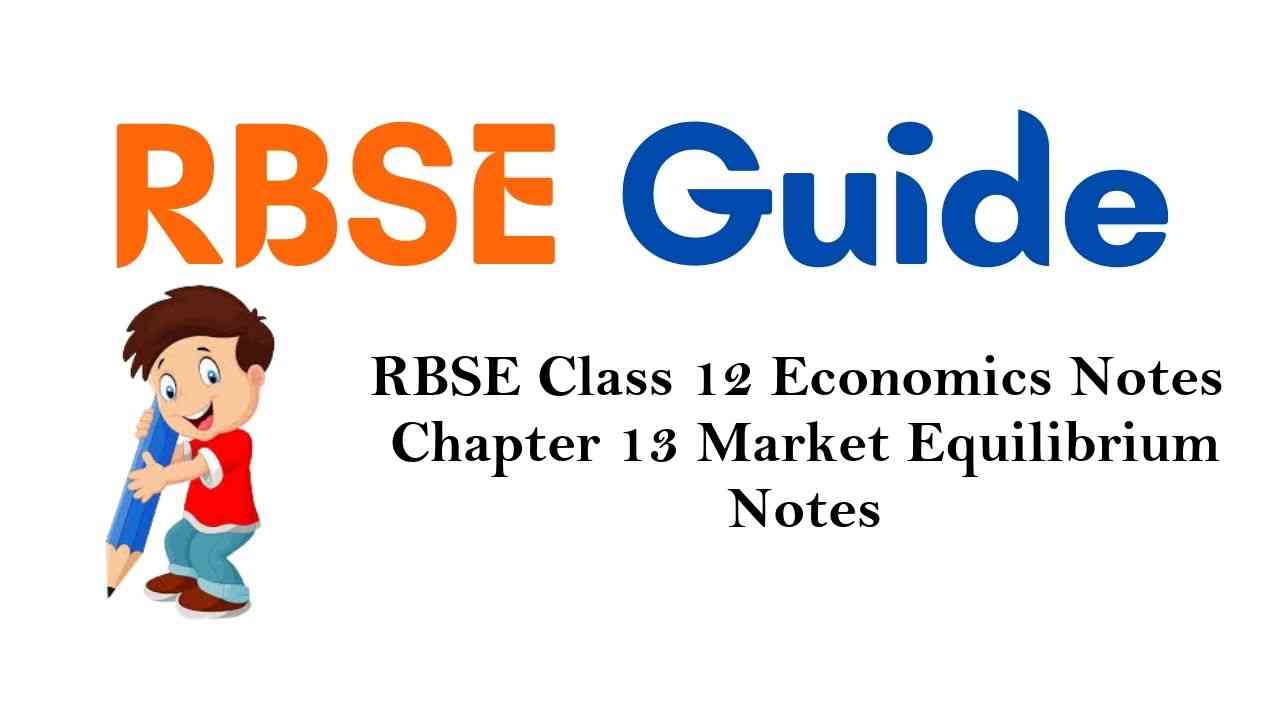Rajasthan Board RBSE Class 12 Economics Notes Chapter 13 Market Equilibrium
In a perfectly competitive market, buyers and sellers work for the objective of profit.
Consumers aim to maximize their respective benefits and the aim of the companies is to maximize their profits.
The stage at which both the consumers and the firms attain their objectives, it is called
the market equilibrium state.
That situation is called the position of equilibrium, in which the total quantity that the firms are willing to sell is equal to the quantity that the consumers are willing to buy. In such a situation, the market supply is equal to the market demand and the market becomes empty and the firms and the consumers do not want to deviate.
The price at which the equilibrium is formed is called the equilibrium price and the total quantity bought and sold at that price is called the equilibrium quantity.
The market demand curve makes it clear that all the consumers are willing to purchase how much quantity or quantities of any item at different prices.
The market supply curve makes it clear that what quantities of any item are the firms prepared to jointly produce and sell at different prices.
![]()
Market equilibrium is determined by market demand and supply.
If market supply is more than market demand at any price, then at that price, the market is said to be in excess supply.
If market demand is more than the market supply at any price, then at this price, the market is called to be in excess demand.
Equilibrium in a perfectly competitive market can optionally be called the status of zero excess demand-zero excess supply.
If there is a fixed number of firms, then the market equilibrium will be at a point where market demand curve cuts the market supply curve.
Changes in demand and supply are due to changes in the factors affecting the demand and supply in the market. The demand and supply curves shift, which affect the equilibrium quantity and demand,
When the demand curve has a fight side shift, the equilibrium quantity and equilibrium price increases, and when the demand curve has a left side shift, the equilibrium quantity and equilibrium price decreases.
Shift in the supply curve can be either to the right or left.
![]()
On the right side shift of the supply curve, equilibrium quantity increases and equilibrium price decreases, whereas if the supply curve shifts left side, it leads to decrease in equilibrium quantity and equilibrium price increases.
If both demand and supply curves are shifted together on the left side then equilibrium quantity decreases and equilibrium price can increase, decrease or remain unchanged.
If both demand and supply curves shift to the right then equilibrium quantity increases and equilibrium price can increase, decrease or remain unchanged.
If the demand curve is shifted on the left side and the supply curve is shifted to the right then the equilibrium price will decrease and the equilibrium quantity will either decrease or remain unchanged.
If demand curve shifts to the right and supply curve shifts to the left, the equilibirum price will increaase, and equilibrium quantity may increase, decrease or remain unchanged.
![]()
If market demand curve shifts towards either left or right side, only the equilibrium quantity will change, and there will be no change in equilibrium price.
The analysis of demand and supply is used by government to fix the higher and lower limits of a commodity’s price.
When both, the demand and supply of a product change, the equilibrium price is also affected.
Important Glossary
- Equilibrium – The condition in which the market supply is equal to the market demand.
- Equilibrium Price – The price at which the equilibrium is established.
- Excess Supply – When market supply at a price exceeds market demand.
- Excess Demand – When market demand at a price exceeds the market supply.
- Market – Market is a system where buyers and sellers come in contact with each other.
- Black Marketing – Selling a product illegally at a price higher than the price fixed by the government.
- Market Demand – The sum total pf different individual demands is called market demand.
- Market Supply Schedule – The sum total of all the individual supply schedules is called Market Supply Schedule.
